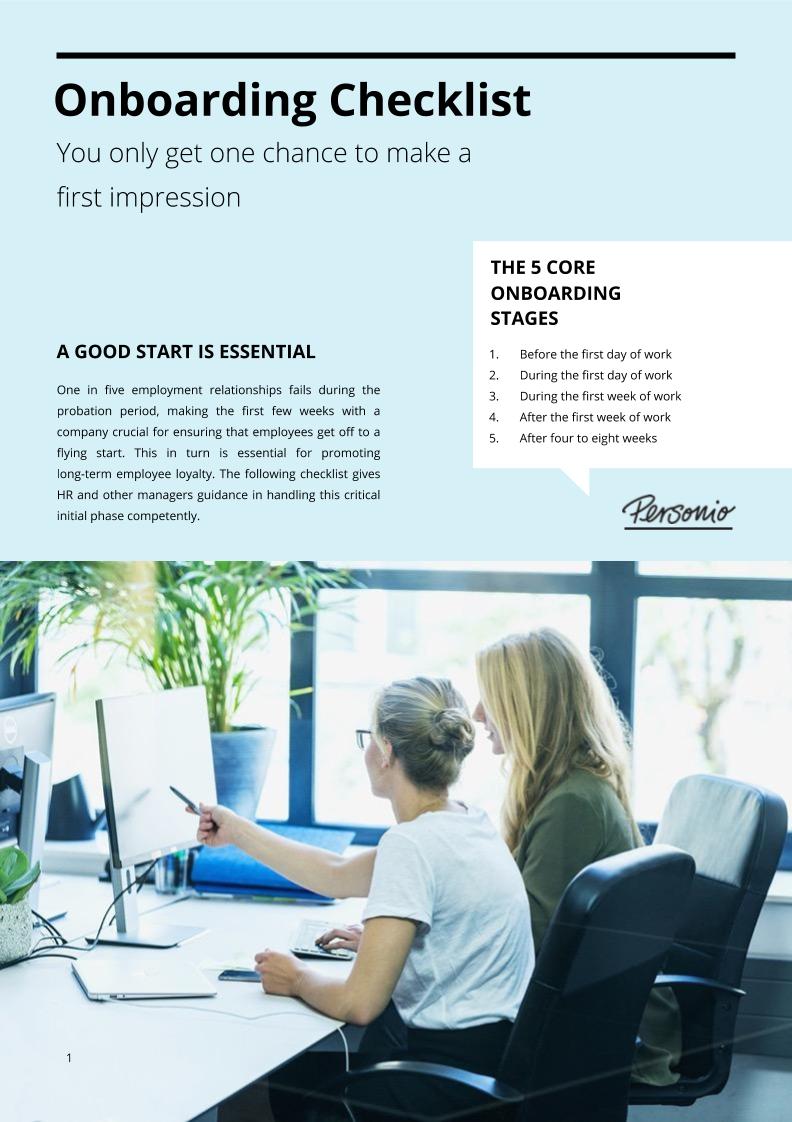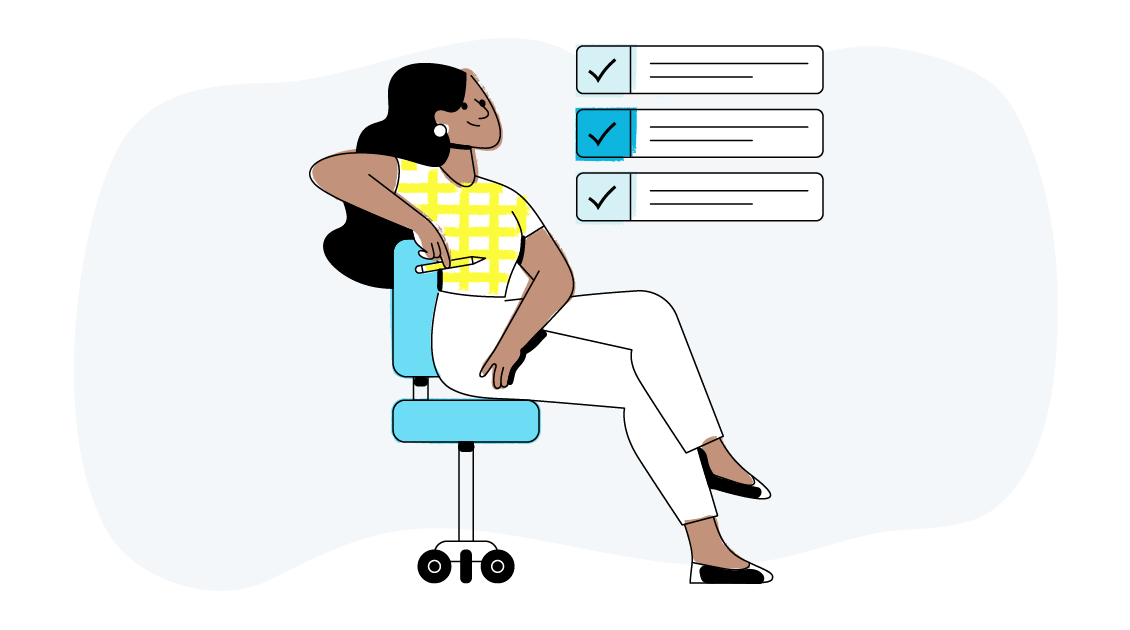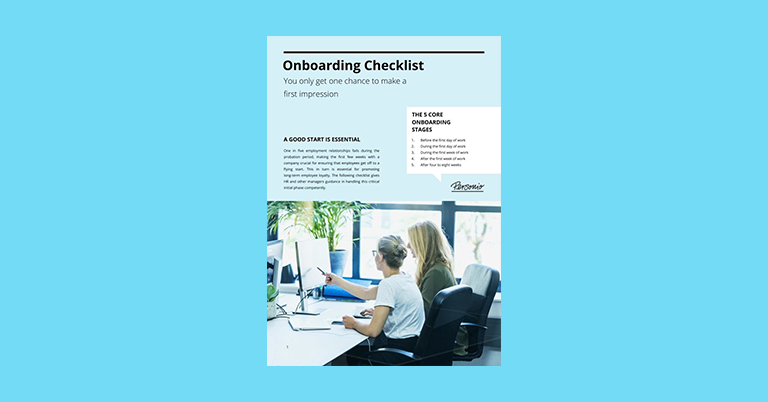Onboarding can be the difference between an okay start, a good start, and a great start, it all depends on how high you prioritize it. To boost your retention rates, alongside your culture, you should give onboarding top priority and focus on it as part of your overall people strategy. In this article, we give you the full story behind why.
Kick things off by downloading our complimentary onboarding checklist right now.
Content
What Is Onboarding?
The Four Phases Of Employee Onboarding
Phase One: Before A New Employee Starts
Phase Two: First Day
Phase Two: The First Week
Phase Three: Following The First Week
Phase Four: Following Weeks
Onboarding Example: How It Works at Mailchimp
Managing Onboarding: How HR Should Help
What Is Onboarding?
Onboarding is making the perfect introduction between a new employee and their organization. More specifically, it is the recruitment and targeted integration of new employees into a company. It does this by using measures to help employees find their best way “on board” at a new company.
Why Is Onboarding Important?
When a new employee joins your company, chances are they are going to have a lot of questions. Not only about their role, but about the company, processes, and maybe even the culture. Onboarding is designed to answer those questions, to prepare an employee for their new role, and to help them meet and integrate with their new coworkers.
What type of company culture do you have? Find out in this article.
What Is The Purpose Of Onboarding?
The idea behind onboarding is to get employees as prepared as possible as quickly as possible. And, to help them succeed at every step. So, the point of great onboarding is not only to orient employees but to help build a psychological connection between them and your business.
Is There A Difference Between Onboarding And Orientation?
Think about it like this: Onboarding, as we expand on in this article, happens in phases. It takes time, typically weeks or maybe even months, to help employees onboard fully. Orientation, on the other hand, is a more short-lived affair (maybe you’ve heard the term ‘orientation day’ or ‘induction day’ before, which encapsulates it nicely).
Click here to check out our induction day checklist article.
How Long Should Great Onboarding Take?
Ideally, onboarding typically lasts between four to eight weeks (depending on the role). That’s because, after that period, you’ll want to have established some long-lasting processes with employees that no longer require onboarding (instead, they become day-to-day work).
How Can You Speed Onboarding Up?
When you think about it like this, it makes having onboarding software all the more important. If onboarding lasts that long, for each new employee, you need to make sure that the steps are always happening at the right time, in the right order, and everyone is kept up to date.
Learn more about automating your onboarding process with Personio today.
The Four Phases Of Employee Onboarding
We’ll break each of these down step-by-step, but the four phases that make up a great professional introduction include:
| Phase One | Before a new employee starts |
| Phase Two | Their first day and week on the job |
| Phase Three | After their first week of work |
| Phase Four | After four to eight weeks |
Let’s dive directly into each…
Phase One: Before A New Employee Starts
As an HR manager, you can help new colleagues quickly settle in and feel comfortable. The entire process should be streamlined and successful, often with the help of HR software, so that new joiners to your company have a completely seamless experience from day one.
Here are some of the common things worth covering during initial onboarding…
1. Formalities
Have all contractual formalities been taken care of? Have access rights been clarified? Does the new employee have the necessary work attire? These types of questions should be addressed a minimum of one to two weeks before a new colleague starts.
2. Information
Does the new employee know when and where to arrive? Does he or she know the essentials of what to expect? This all should be communicated in advance over email (click here for some helpful new employee introduction emails).
3. Colleagues
All colleagues involved in the process should be provided with all necessary information. In fact, they should be aware of their respective ‘to-do-lists.’
This would typically include secretarial, office management, and IT personnel. It might also be worth considering including mentors who will provide support during the employee’s first few days on the job.
4. Workplace
Ideally, the new employee will arrive on the very first day to a fully functional workplace. Ensuring that everything is in place will require a certain degree of lead time. So, preparations should be made well in advance. This includes:
- Access to the building should be functional from day one. This frequently requires procuring a new entry code or having a new key made.
- Each employee should be provided with their own computer, which will have to be newly set up when staff members change or when new equipment is purchased. Please remember to take the delivery time into consideration when purchasing new equipment.
- The same is optional for a company mobile phone and a company car.
- Workplace/seating in general: Does the new colleague have an assigned place? And, do they also have a monitor, chair, keyboard, and mouse? Do they have something to write with and on?
- The information needed for data access must be generated at an early stage, including passwords, access rights, and invitations to use certain tools. This way, new colleagues can set up their virtual workspace on the first day. This will save a lot of time in the process.
- Do additional licenses for certain programs need to be purchased for the new employee?
Automate Your Onboarding With Personio
Keep track of every new addition to your team, welcome them with automated emails, and build an onboarding process your company can be proud of — all with Personio.
5. Deadlines
Invite the new colleague to upcoming meetings. If possible, arrange appointments with the most important people they will be interacting with (in both their own and in other departments).
6. Employee Training
Does the new colleague need additional training in a specific area? This training should be booked before the start of employment so that the training period for particular topics is not delayed.
7. Responsibilities
If a new employee is coming into a position that did not previously exist, responsibilities will often be redistributed.
The team leader is responsible for communicating this in detail to the current employees. As part of onboarding, the HR manager in charge should double-check to make sure that any potential resentment toward the new colleague is avoided.
8. Welcome Gift
The day before the new employee starts, you or one of your colleagues can purchase a little gift to celebrate their start in their new working environment. It could be chocolates, a small bunch of flowers, or something along those lines. You can read below about why this particular point belongs to a successful onboarding experience.
Phase Two: First Day
1. Punctuality
On the first day, you should show appreciation for your new colleague by arriving promptly. It often happens that a new colleague will arrive punctually at the office, but the person assigned to help them is still in a meeting or unavailable.
To spare your new colleagues the typical Monday morning chaos, and to carve out sufficient preparation time for yourself, simply allow them to begin work that day an hour later than usual.
2. Welcoming Culture
The little welcoming gift has, hopefully, been taken care of before the new employee’s first day of work (see above). Now, its effect can be allowed to unfold.
From the first second they arrive, little niceties like this enhance your new team member’s sense of belonging. They will also remain a pleasant memory. Ultimately, small gestures can have a large impact.
3. Introductions
To get off to a good start, we recommend that you arrange a small introductory get-together.
Of course, this doesn’t mean that the entire company has to be waiting in the new person’s office on the first day. However, the colleagues they will be directly working with should introduce themselves and clarify their areas of responsibility.
This will make it easier for your new colleague to establish contact. It will also reduce any hesitance they may feel in asking someone directly for help.
4. Team Strengthening
Having lunch together with colleagues from the same department on the first day of work strengthens the sense of community in an organization. It also creates a basis of trust for working together in the future.
Free Download: Onboarding Checklist

Phase Two: The First Week
Onboarding Preview
To make it clear how things will run over the coming days or weeks, the process should be fully explained to the new employee. This can also be aided by streamlined onboarding software, too.
When helping new colleagues orient themselves, be sure not to overwhelm them by only providing verbal information. Give them as much written documentation as possible.
If your HR software has an onboarding feature, then set up tasks and reminders. Click here to learn more about how HR software can help throughout the process.
Mutual Expectations
Supervisors should review the new job responsibilities with the employee and communicate their expectations. On the other hand, it is also important that employees be allowed to clearly express their expectations for the next few weeks.
This way, misunderstandings can be avoided before they occur and an enjoyable working atmosphere can be created.
Initial Activities
From the beginning, the new colleague should be integrated into existing projects. At the beginning, having exciting initial activities can inspire an employee’s enthusiasm for the company.
Legal Matters
If there are SOPs (Standard Operating Procedures) associated with the new employee’s work, these must be carefully read and signed before certain activities are performed.
Company Tour
To give the new employee a clear picture of what happens where and who is responsible for each department, a tour to all of the other departments should now be conducted.
Tip: For companies with more than 30 employees, a photo gallery on the intranet or a photo wall in the office where new employees can see is a great help.
Product Introduction
A detailed product presentation is an essential element of onboarding. Especially for colleagues from non-product-related areas, such as accounting, it is important that they know which products/services the company offers.
If several new colleagues are starting work on the same day, this type of presentation also offers a great opportunity to get to know people from other departments.
Corporate Goals
What are the corporate goals and what strategies are being followed to pursue them?
Be sure that your goals are clear to your new employee: for example, share what you want to achieve in the next quarter and let them know precisely why their contribution will make a difference. These goals should then also be reflected in the employee’s target agreement.
Corporate Culture
Knowing which values are important to the company is crucial to helping new employees identify with their employer. This is especially true if the new colleague is coming from a different corporate environment (click here to read our definitive guide to corporate culture).
For example, if they have moved from a start-up to a large corporation, the new environment can be quite different from their previous experience. Here, too, it will be important to pay attention to the little things, such as:
- Do we sometimes go for lunch together?
- Are smoking breaks permitted?
- What about working from home?
Make sure to explain the values that apply to all employees equally. And, in some cases, ensure that your onboarding software also has the opportunity to communicate these things through various documents and materials, too.
Team Spirit
It can often be difficult for new colleagues to integrate themselves into existing ‘employee groups.’ Nothing is worse than having to eat lunch alone during the first week of work because, once the first day is over, no one takes responsibility for the new employee.
Make sure your team includes the new colleague at lunchtime and that a sense of togetherness always develops.
Phase Three: Following The First Week
1. Gather First Impressions
Solicit input from your new employee. What positive or negative observations did they make during the first week? The longer you work in a company, the more you get used to the way things work there. This always includes both positives and negatives.
2. Follow-Up Information
During the first week, your new employee will have to process a multitude of impressions. Give information a little at a time rather than all at once. By the end of the first week, at the latest, the new employee should know/have everything they need. This would include such things as vacation guidelines, working hours, lists of abbreviations, etc.
Phase Four: Following Weeks
1. Ongoing Feedback
If, after the first few weeks on the job, there is no review of the employee’s experience, then even the best process is of little value.
It is crucial that, after a pre-determined period of time, a feedback session is held with new colleagues, and that this process is repeated regularly. This can often be aided by onboarding software.
This is not just so that you can evaluate your new employee’s conduct and work, but also so that they can openly give you feedback about their first impressions of the company.
2. Networking
If several colleagues from different departments all start work on the same day, you can promote interdepartmental networking by organizing a joint lunch date a few weeks after they have started.
The awareness of a common start date makes it easier for colleagues to stay in touch. This, in turn, nurtures an even more positive working environment.
Onboarding Example: How It Works at Mailchimp
Every year, around 200 new employees go through onboarding at Mailchimp. That is why assigned ‘Employee Integration Associates’ ensure that every new person feels welcome. And, that they have all the resources they need.
Some of the highlights of this program include:
- A tour through all of the most important offices/locations
- Chats with two of the co-founders
- Complimentary lunches
Speaking of lunch – no one should have to eat alone. That’s why, in the first week, individual people go to lunch with new colleagues to help them feel welcome.
Before new employees start, they fill out a list of their favorite snacks, colors, hobbies, etc. The team then uses this information to set up their workspace.
Managers also send greetings on postcards and take new colleagues to informal meetings. This helps them integrate more quickly and seamlessly.
Onboarding lasts for one week. Before the start of their first workday, new colleagues receive an email letting them know what will take place during this time.
At the end of the week, they review their experience with the Employee Integration Associate and share their opinion on how things went.
Managing Onboarding: How HR Should Help
- Create an onboarding process that covers the different tasks in the five onboarding phases and specifies which internal departments are responsible for the upcoming tasks at which point in time.
- Clarify responsibilities and lead times in advance. This applies, for example, to the provision of time and access cards, employee ID cards, office supplies, PCs, software, and access points. The same applies to the provision of data in payroll accounting and the creation of a personnel file. Plan realistically for lead times.
- Create a checklist. In it, record the administrative steps as well as the professional and social tasks of the HR department, the manager, and the team. You can download our onboarding checklist here.
- Use HR software that automates the individual steps of onboarding – from administrative tasks to the onboarding plan. This way, HR keeps track of everything and onboarding runs more efficiently.
Read our full guide on optimizing the onboarding process right here.
Make Onboarding A Priority Today
Now you should have a better idea of how onboarding works, and the four key phases that can help ensure success. So, when you have new people join your organization, you can ensure that they can get off to a great start (and maintain their performance over time).
Automate Your
Onboarding Today






